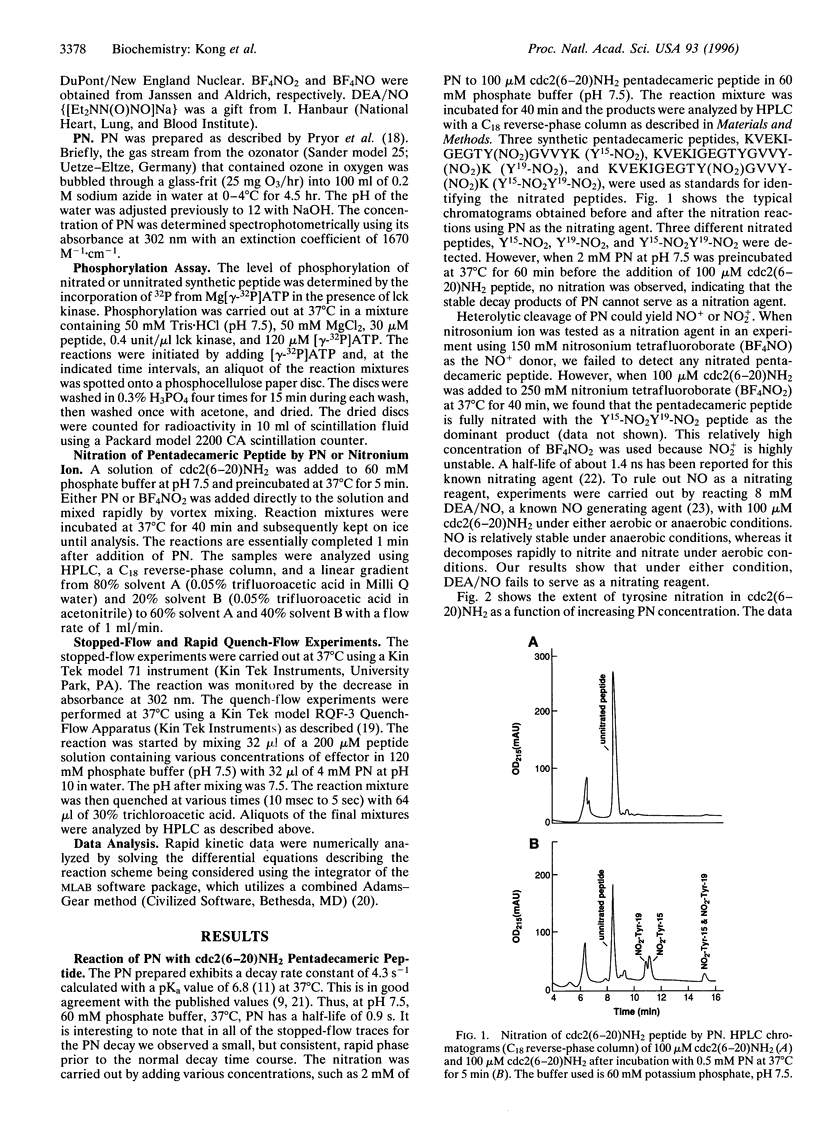Abstract
To determine if nitration of tyrosine residues by peroxynitrite (PN), which can be generated endogenously, can disrupt the phosphorylation of tyrosine residues in proteins involved in cell signaling networks, we studied the effect of PN-promoted nitration of tyrosine residues in a pentadecameric peptide, cdc2(6-20)NH2, on the ability of the peptide to be phosphorylated. cdc2(6-20)NH2 corresponds to the tyrosine phosphorylation site of p34cdc2 kinase, which is phosphorylated by lck kinase (lymphocyte-specific tyrosine kinase, p56lck). PN nitrates both Tyr-15 and Tyr-19 of the peptide in phosphate buffer (pH 7.5) at 37 degrees C. Nitration of Tyr-15. which is the phosphorylated amino acid residue, inhibits completely the phosphorylation of the peptide. The nitration reaction is enhanced by either Fe(III)EDTA or Cu(II)-Zn(II)-superoxide dismutase (Cu,Zn-SOD). The kinetic data are consistent with the view that reactions of Fe(111)EDTA or Cu,Zn-SOD with the cis form of PN yield complexes in which PN decomposes more slowly to form N02+, the nitrating agent. Thus, the nitration efficiency of PN is enhanced. These results are discussed from the point of view that PN-promoted nitration will result in permanent impairment of cyclic cascades that control signal transduction processes and regulate cell cycles.
Full text
PDF





Selected References
These references are in PubMed. This may not be the complete list of references from this article.
- Banik U., Zhu D. M., Chock P. B., Miles E. W. The tryptophan synthase alpha 2 beta 2 complex: kinetic studies with a mutant enzyme (beta K87T) to provide evidence for allosteric activation by an aminoacrylate intermediate. Biochemistry. 1995 Oct 3;34(39):12704–12711. doi: 10.1021/bi00039a029. [DOI] [PubMed] [Google Scholar]
- Beckman J. S., Ischiropoulos H., Zhu L., van der Woerd M., Smith C., Chen J., Harrison J., Martin J. C., Tsai M. Kinetics of superoxide dismutase- and iron-catalyzed nitration of phenolics by peroxynitrite. Arch Biochem Biophys. 1992 Nov 1;298(2):438–445. doi: 10.1016/0003-9861(92)90432-v. [DOI] [PubMed] [Google Scholar]
- Berlett B. S., Friguet B., Yim M. B., Chock P. B., Stadtman E. R. Peroxynitrite-mediated nitration of tyrosine residues in Escherichia coli glutamine synthetase mimics adenylylation: relevance to signal transduction. Proc Natl Acad Sci U S A. 1996 Mar 5;93(5):1776–1780. doi: 10.1073/pnas.93.5.1776. [DOI] [PMC free article] [PubMed] [Google Scholar]
- Cheng H. C., Nishio H., Hatase O., Ralph S., Wang J. H. A synthetic peptide derived from p34cdc2 is a specific and efficient substrate of src-family tyrosine kinases. J Biol Chem. 1992 May 5;267(13):9248–9256. [PubMed] [Google Scholar]
- Draetta G., Piwnica-Worms H., Morrison D., Druker B., Roberts T., Beach D. Human cdc2 protein kinase is a major cell-cycle regulated tyrosine kinase substrate. Nature. 1988 Dec 22;336(6201):738–744. doi: 10.1038/336738a0. [DOI] [PubMed] [Google Scholar]
- Huie R. E., Padmaja S. The reaction of no with superoxide. Free Radic Res Commun. 1993;18(4):195–199. doi: 10.3109/10715769309145868. [DOI] [PubMed] [Google Scholar]
- Hunter T. Protein kinases and phosphatases: the yin and yang of protein phosphorylation and signaling. Cell. 1995 Jan 27;80(2):225–236. doi: 10.1016/0092-8674(95)90405-0. [DOI] [PubMed] [Google Scholar]
- Ischiropoulos H., Zhu L., Chen J., Tsai M., Martin J. C., Smith C. D., Beckman J. S. Peroxynitrite-mediated tyrosine nitration catalyzed by superoxide dismutase. Arch Biochem Biophys. 1992 Nov 1;298(2):431–437. doi: 10.1016/0003-9861(92)90431-u. [DOI] [PubMed] [Google Scholar]
- King R. W., Jackson P. K., Kirschner M. W. Mitosis in transition. Cell. 1994 Nov 18;79(4):563–571. doi: 10.1016/0092-8674(94)90542-8. [DOI] [PubMed] [Google Scholar]
- Knott G. D. Mlab--a mathematical modeling tool. Comput Programs Biomed. 1979 Dec;10(3):271–280. doi: 10.1016/0010-468x(79)90075-8. [DOI] [PubMed] [Google Scholar]
- Maragos C. M., Morley D., Wink D. A., Dunams T. M., Saavedra J. E., Hoffman A., Bove A. A., Isaac L., Hrabie J. A., Keefer L. K. Complexes of .NO with nucleophiles as agents for the controlled biological release of nitric oxide. Vasorelaxant effects. J Med Chem. 1991 Nov;34(11):3242–3247. doi: 10.1021/jm00115a013. [DOI] [PubMed] [Google Scholar]
- Mayer B., Klatt P., Werner E. R., Schmidt K. Kinetics and mechanism of tetrahydrobiopterin-induced oxidation of nitric oxide. J Biol Chem. 1995 Jan 13;270(2):655–659. doi: 10.1074/jbc.270.2.655. [DOI] [PubMed] [Google Scholar]
- Moncada S., Palmer R. M., Higgs E. A. Nitric oxide: physiology, pathophysiology, and pharmacology. Pharmacol Rev. 1991 Jun;43(2):109–142. [PubMed] [Google Scholar]
- Nathan C. F., Hibbs J. B., Jr Role of nitric oxide synthesis in macrophage antimicrobial activity. Curr Opin Immunol. 1991 Feb;3(1):65–70. doi: 10.1016/0952-7915(91)90079-g. [DOI] [PubMed] [Google Scholar]
- Pryor W. A., Cueto R., Jin X., Koppenol W. H., Ngu-Schwemlein M., Squadrito G. L., Uppu P. L., Uppu R. M. A practical method for preparing peroxynitrite solutions of low ionic strength and free of hydrogen peroxide. Free Radic Biol Med. 1995 Jan;18(1):75–83. doi: 10.1016/0891-5849(94)00105-s. [DOI] [PubMed] [Google Scholar]
- Pryor W. A., Jin X., Squadrito G. L. One- and two-electron oxidations of methionine by peroxynitrite. Proc Natl Acad Sci U S A. 1994 Nov 8;91(23):11173–11177. doi: 10.1073/pnas.91.23.11173. [DOI] [PMC free article] [PubMed] [Google Scholar]
- Radi R., Beckman J. S., Bush K. M., Freeman B. A. Peroxynitrite oxidation of sulfhydryls. The cytotoxic potential of superoxide and nitric oxide. J Biol Chem. 1991 Mar 5;266(7):4244–4250. [PubMed] [Google Scholar]
- Schlessinger J. SH2/SH3 signaling proteins. Curr Opin Genet Dev. 1994 Feb;4(1):25–30. doi: 10.1016/0959-437x(94)90087-6. [DOI] [PubMed] [Google Scholar]
- Stadtman E. R., Chock P. B. Interconvertible enzyme cascades in metabolic regulation. Curr Top Cell Regul. 1978;13:53–95. doi: 10.1016/b978-0-12-152813-3.50007-0. [DOI] [PubMed] [Google Scholar]


